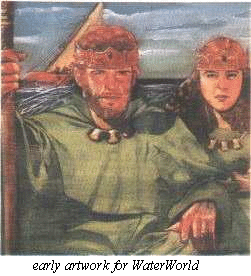“… make sure that you don’t agree to anything about canceling the contest.” That’s what they said to him after he won the competition. Ominous advice from the Swordquest veterans. What could it mean? What could they know? Were they just messing with Michael Rideout’s head, or did they have legitimate concern? Discover the truth with us as we dive into the third piece of Atari’s jewel-encrusted puzzle, Swordquest: WaterWorld.
To recap the story thus far, Swordquest was the brainchild of Atari programmer Tod Fyre, whose intention was to draw attention back to their 2600 VCS and reclaim its past glory. It was the spiritual successor to Adventure, one of Atari’s greatest hits, and was to encompass four separate games: EarthWorld, FireWorld, WaterWorld, and AirWorld. Each game’s release would be followed by a related gaming competition held at Atari’s headquarters in Sunnydale, CA, the winner of which would receive a solid gold, jewel-encrusted prize, valued by Atari at $25,000. The winners of each competition would then collide in a monumental meet of champions, with the supreme Swordquest master going home with the titular $50,000 Sword of Ultimate Sorcery. Both the EarthWorld and FireWorld competitions went off virtually hitchless, with their winners heading home with their respective Talisman and Crown.
 Swordquest: WaterWorld invoked the same “find and place items” style of gameplay as its two predecessors, with the only notable difference being a marginal decrease in the number of items and places. If you’re really that desperate for knowledge about what one actually did in WaterWorld, check out this page, because it’s really not worth going over yet again. Suffice to say the game was boring, but that didn’t matter because very few people were even able to play it.
Swordquest: WaterWorld invoked the same “find and place items” style of gameplay as its two predecessors, with the only notable difference being a marginal decrease in the number of items and places. If you’re really that desperate for knowledge about what one actually did in WaterWorld, check out this page, because it’s really not worth going over yet again. Suffice to say the game was boring, but that didn’t matter because very few people were even able to play it.
Due to the low sales and general lack of interest in the two first Swordquest titles, WaterWorld was offered only through the Atari Fan Club. In addition, the number of finalists to be allowed in the competition was dropped from fifty to ten, causing many people to get their knickers in a twist. All together Atari received forty-five submissions from gamers who had discovered all four required clues. These gamers were then required to write an essay with the starting line of “What I like about the Atari WaterWorld video adventure is…”, and the gamers with the top ten best entries (as judged by an independent judging agency) would have been invited to the competition. Would have been, that is, had the competition actually ever taken place.
Jack Tramiel, the original founder of Commodore, purchased Atari from owner Warner Communications during the summer of 1986. Tramiel promptly renamed the company Atari Corporation and fired the majority of its employees. He then sent letters to the ten decided finalists of WaterWorld, offering them each $2,000 to agree to cancel the Swordquest contest. All ten finalists agreed. He also sent letters to the winners of the first two competitions, Steven Bell and Michael Rideout, offering them each $15,000 to agree to cancel the Swordquest contest. Both winners agreed. The contest was then officially canceled, and Swordquest was officially dead and buried.
The three remaining prizes, crown, Philosopher’s Stone, and sword, are all thought to be in the possession of Jack Tramiel. Since the WaterWorld competition never took place, there was no need for him to award the crown to anybody. The fourth game, AirWorld, was only 20% complete at the time of Swordquest‘s demise, and was never completed or released. Everyone was given their money, and Swordquest was soon forgotten by all.
Well, not quite by all.
This concludes Part Three of our ongoing Swordquest coverage. Could this really conclude the entire series? Take a sip next month as we end this epic four-parter, and examine the existence of, or lack-there-of, Swordquest: AirWorld. Trust me, this would be a terrible time to stop reading.
